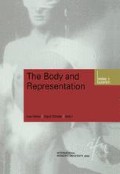Abstract
In the late 60s Western feminism was based on a uniform and homogeneous feminine identity, the result of a social structure now taken as a basis for a critical redefinition of the positions of the sexed bodies. There were different conditionings to be that way: the social context, the logic of construction of social problems, the influence of different theorisations about other social positions and conflicts and the traditional dualist way of thinking, among others. Nevertheless, the progressive development of differences and the influence of poststructuralisms are leading to the deconstruction of the unilateral vision of the subject’s construction and constitution. Within this background, the question to be faced is if we deconstruct ‘woman’ who is the subject/object/agent for feminism?
I want to thank the organisers and the participants for making the IFU possible.
Access this chapter
Tax calculation will be finalised at checkout
Purchases are for personal use only
Preview
Unable to display preview. Download preview PDF.
Literature
Anzaldúa, G. (1990). La conciencia de la mestiza. In G. Anzaldúa (Ed.), Making face, making soul/Haciendo Caras (pp. 377–389 ). San Francisco: Aunt Lute.
Anzaldúa, G. (1981). La Prieta. In Ch. Moraga & G. Anzaldúa (Eds.), This bridge called me back. Watertown (p. 205 ), Massaschuttches: Persephone Press.
Braidotti, R. (1994). Nomadic Subjects. New York: Columbia University Press.
Haraway, D. (1992). Ecce homo, Ain’t (Ar’n’t) I a woman and inapporpriate/d Others. In J.
Butler & J. Scott (Eds.), Feminist theorize the political (pp. 86–101). London, New
York: Routledge.
Haraway, D. (1989). A manifesto for cyborgs. In L. Nicholson (Ed.), Feminism/Postmodernism. London and New York: Routledge.
Kaplan, C. (1994). The politics of location as transnational feminist practice. In I. Grewal & C. Kaplan (Eds.), Scattered Hegemonies (pp. 137–152 ). Minneapolis: University of Minnesota Press.
Lakoff, G. & Johnson, M. (1991). Metâforas de la vida cotidiana. Madrid: Câtedra.
Mohanty, Ch. (1992). Feminist encounters. In M. Barret & A. Phillips (Eds.), Destabilizing theory (pp. 74–92 ). Cambridge: Polity Press.
Editor information
Editors and Affiliations
Rights and permissions
Copyright information
© 2002 Springer Fachmedien Wiesbaden
About this chapter
Cite this chapter
Casado-Aparicio, E. (2002). Engendered Bodies: Metaphors in Feminism. In: Härtel, I., Schade, S. (eds) Body and Representation. Schriftenreihe der Internationalen Frauenuniversität »Technik und Kultur«, vol 6. VS Verlag für Sozialwissenschaften, Wiesbaden. https://doi.org/10.1007/978-3-663-11622-6_8
Download citation
DOI: https://doi.org/10.1007/978-3-663-11622-6_8
Publisher Name: VS Verlag für Sozialwissenschaften, Wiesbaden
Print ISBN: 978-3-8100-3254-6
Online ISBN: 978-3-663-11622-6
eBook Packages: Springer Book Archive

